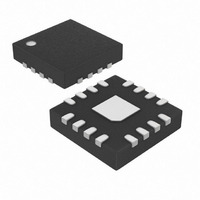MAX9512ATE+ Maxim Integrated Products, MAX9512ATE+ Datasheet - Page 14

MAX9512ATE+
Manufacturer Part Number
MAX9512ATE+
Description
IC AMP VIDEO FILTER 16-TQFN
Manufacturer
Maxim Integrated Products
Datasheet
1.MAX9512ATET.pdf
(19 pages)
Specifications of MAX9512ATE+
Applications
Filter
Number Of Circuits
1
Current - Supply
13mA
Voltage - Supply, Single/dual (±)
2.7 V ~ 3.6 V
Mounting Type
Surface Mount
Package / Case
16-TQFN Exposed Pad
Number Of Channels
2
Supply Current
13 mA
Minimum Operating Temperature
- 40 C
Maximum Operating Temperature
+ 125 C
Maximum Power Dissipation
1250 mW
Mounting Style
SMD/SMT
Supply Voltage (max)
3.6 V
Supply Voltage (min)
2.7 V
Lead Free Status / RoHS Status
Lead free / RoHS Compliant
Video Filter Amplifier with SmartSleep
and Y/C Mixer Circuit
The MAX9512 video inputs YIN and CIN should be
directly connected to the output of the video current
DAC. DC-coupling ensures that the input signals are
ground referenced such that the sync tip of the luma
signal is within 50mV of ground and the blank level of
the chroma signal is between 0.5V and 0.65V.
The MAX9512 filter passband is 6.75MHz, which makes
the device suitable for the higher bandwidth video sig-
nals from a DVD chip. Broadcast video signals actually
require less bandwidth because of channel limitations:
NTSC signals have 4.2MHz bandwidth, and PAL signals
have 5MHz bandwidth. Video signals from a DVD player
are not channel limited; therefore, the bandwidth of DVD
video signals can push right against the Nyquist limit of
6.75MHz. (Recommendation ITU-R BT.601-5 specifies
13.5MHz as the sampling rate for standard-definition
video). Therefore, the maximum bandwidth of the signal
is 6.75MHz. To ease the filtering requirements, most
modern video systems oversample by two times, clock-
ing the video current DAC at 27MHz.
The Y/C mixer adds the luma and chroma signals
together to create a composite video signal. Since
chroma is a phase modulated carrier at 3.58MHz for
NTSC and 4.43MHz for PAL, the chroma signal is AC-
coupled into the Y/C mixer so that the variation in blank
level from one video source to another video source
does not affect the DC bias of the composite video sig-
nal. The highpass corner frequency of the chroma AC-
coupling circuit is 300kHz.
The video output amplifiers can both source and sink
load current, allowing output loads to be DC- or AC-
coupled. The amplifier output stage needs about
300mV of headroom from either supply rail. The
MAX9512 has an internal level shift circuit that positions
the sync tip at approximately 300mV at the output. The
14
______________________________________________________________________________________
Video Reconstruction Filter
Y/C Mixer
Outputs
Inputs
blank level of the chroma output is positioned at
approximately 1.3V if the blank level of the chroma
input signal is 0.5V. The blank level of the chroma out-
put is positioned at approximately 1.5V if the blank level
of the chroma input signal is 0.6V.
If the supply voltage is greater than 3.135V (5% below
a 3.3V supply), each amplifier can drive two DC-cou-
pled video loads to ground. If the supply is less than
3.135V, each amplifier can drive only one DC-coupled
or AC-coupled video load.
When SHDN is low, the MAX9512 draws less than 1µA
supply current. All the amplifier outputs become high
impedance. The effective output resistance at the video
outputs is 28kΩ, due to the internal feedback resistors
to ground.
YIN and CIN have high-impedance input buffers and
can work with source resistances as high as 300Ω. To
reduce power dissipation in the video DACs, the DAC
output resistor can be scaled up in value. The refer-
ence resistor that sets the reference current inside the
video DACs must also be similarly scaled up. For
instance, if the output resistor is 37.5Ω, the DAC must
source 26.7mA when the output is 1V. If the output
resistor is increased to 300Ω, the DAC only needs to
source 3.33mA when the output is 1V.
There is parasitic capacitance from the DAC output to
ground. That capacitance in parallel with the DAC out-
put resistor forms a pole that can potentially roll off the
frequency response of the video signal. For example,
300Ω in parallel with 50pF creates a pole at 10.6MHz.
To minimize this capacitance, reduce the area of the
signal trace attached to the DAC output as much as
possible, and place the MAX9512 as close to the video
DAC outputs as possible.
Reducing Power Consumption in
Applications Information
the Video DACs
Shutdown










